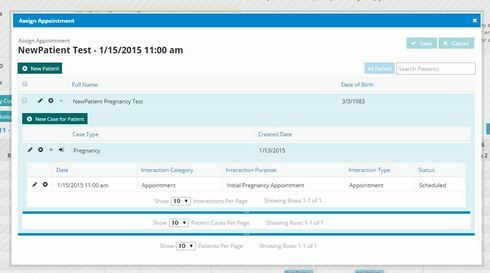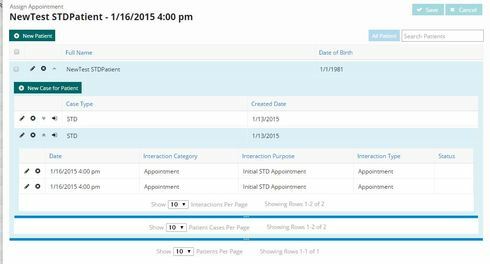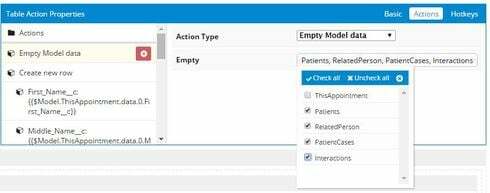Here’s a complex one. Have at it, friends!
Interaction Object is a child of Case Object is a child of Patient Object. There is a lookup relationship between Appointment Object and Interaction Object.
I have a Scheduling Page with a calendar component which has the AppointmentModel as its event source. On calendar click I load a custom popup, and the user fills in data into the AppointmentModel. Then, the user can click a button in the page title component on the popup to save the data and open a second popup, which has a page include with the following:
I have a table on PatientModel, with a drawer containing a table on the CaseModel, with another drawer containing a table on the InteractionModel.
I have a global action button on the PatientModel table that adds a new row to PatientModel with default values from an AppointmentModel.
I have a global action button on the CaseModel table that adds a new row to the CaseModel with default values from an AppointmentModel.
I have a row action on the CaseModel table that adds a new row to the InteractionsModel with default values from an AppointmentModel.
I have an action set up in the PatientModel such that when a row is added, a new row is created in a CaseModel with values from the AppointmentModel.
I have an action set up in the CaseModel such that when a row is added, a new row is created in the InteractionModel with values from the AppointmentModel.
If I run the page-include as a stand-alone page, this works great. However, when I run it through the Scheduling Page through the page include, not so much.
PROBLEM: When I use any Create New Row action, it adds a number of rows to the child object equal to the number of times that I’ve opened the popup since load of the parent page.
For example:
I create an appointment, save and open the Assign Appointment popup with a button. There is nothing in the PatientModel (and therefore nothing in its child or grandchild).
I run the New Patient action, and get this result:
As expected, a row is added to the PatientModel with values from the AppointmentModel, which triggers a row being added to the CaseModel, which triggers a row being added to the InteractionModel. Perfect.
Now, if I close the popup, reopen it (doesn’t make a difference if it’s the same context row on AppointmentModel, or a different one), and run the same action a second time, here is what I get:
Two rows in CaseModel, and in each of them, two rows in InteractionsModel (4 total).
If I close it and open it again, I can create three identical rows in the CaseModel, each with three identical rows in the InteractionsModel, all with a single click!
Strange, right?
Here’s the basic question:
Why would having a page include popup from a calendar popup cause duplication of the ''create new row" action once for every time the popup has been opened since pageload?
Question
Add new row action adds multiple rows
 +18
+18Enter your E-mail address. We'll send you an e-mail with instructions to reset your password.






